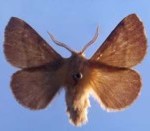Byline: Juliette Wallack
BOSTON — The destruction is obvious through much of southeastern Massachusetts: Trees stripped of their leaves dot the landscape, leaving mostly brown and gray where green once was. Many of the leaves that have managed to withstand the attack bear evidence of the assault -- tiny bite marks and nibbles.
Faced with outbreaks of two moth species known for their steady diet of leaves, experts are working to control the pesky critters and discover what is causing their spiraling numbers and widespread defoliation they leave in their paths.
The rapidly increasing populations of the two species are causing "widespread deforestation in Massachusetts," said Joe Elkinton, an entomology professor at University of Massachusetts.
Winter moths and forest tent caterpillars have been eating leaves and buds around the state this spring, causing concern among scientists who are trying to figure out what's causing their numbers to skyrocket. The pests have hit the southeastern part of the state particularly hard. Earlier this month, Rhode Island officials said there was a "caterpillar explosion" in the state, and said winter moths had damaged maple, elm and basswood trees in Newport and Bristol counties. They warned the moths had been detected in Warwick, indicating they could spread throughout the state.
Earlier this month, Rhode Island officials said there was a "caterpillar explosion" in the state, and said winter moths had damaged maple, elm and basswood trees in Newport and Bristol counties. They warned the moths had been detected in Warwick, indicating they could spread throughout the state.
"In the 20-some years I've been doing this, I have never really seen it like this," said Robert Childs, an entomologist at the UMass Extension.
The widespread defoliation reminds many of the gypsy moth invasion in the 1980s. This year, a fungal infection is keeping the gypsy moths at bay, but winter moths aren't susceptible to the fungus.
Moths eat leaves only during their caterpillar stage, which usually occurs during the late spring and early summer. During that time, the hairy bugs can eat large numbers of leaves and buds, destroying foliage and in some cases ruining hope of blossoms or fruit.
Experts are particularly concerned about a population explosion among winter moths, first discovered in the United States about five years ago.
Scientists are working on ways to control winter moths naturally, including using a small fly that is a parasite of the winter moth. But moths have one-year life cycles, so it takes time to come up with a system that effectively controls them and keeps them in check.
In the meantime, the population of winter moths is growing and they could continue wreaking havoc around the state. Though Plymouth County is considered the "epicenter" for the moth's introduction to the eastern seaboard, the moth has spread to nearly every coastal Massachusetts town, as well as Martha's Vineyard and Rhode Island, Childs said. And the moths have been slowly making their way westward.
Even outside of state forests and arboretums, Massachusetts residents are seeing the aftermath.
"We have seen little nibbles," said Chris Kennedy, a certified horticulturist and manager of Kennedy's Country Gardens, a garden store in Scituate
Pesticides have helped Kennedy prevent damage from caterpillars, but state and city agencies can't always spray the large areas that need protection. But while the defoliation might look devastating, it doesn't necessarily mean the situation is dire.
"One year the caterpillar will completely devastate a tree," Kennedy said, but "hopefully the leaves will come back in again." Most at risk are younger trees that can't recover from the caterpillars.
Forest tent caterpillars are also thriving. The population hasn't been this large in more than 100 years, Childs said. But experts expect the population could drop as soon as next year.
"Usually with our native caterpillars, when they do get to outbreak phase, they usually roar along for three years until the natural controls catch up to them," Childs said.
Natural controls include birds, which eat caterpillars.
"When you get an outbreak, then the birds get overwhelmed," Elkinton said.
Boston's Parks Department is having trouble controlling the destruction because it can't spray city trees, said city arborist Greg Mosman.
Though Mosman is seeing less destruction this year than in recent years, "I'm seeing more dead trees this year," the result of last year's moths burrowing into buds.
The moths don't necessarily kill the trees upon which they feed; in most cases, the trees simply grow new leaves the next spring. Young trees can die as a result of having their leaves eaten, but more mature trees aren't susceptible.
Winter moths will likely not cause more destruction; they've developed beyond the phase during which they eat leaves. But the defoliation will continue as the forest tent caterpillars reach their adult phase. Childs cautioned that scientists are watching another moth species, fall cankerworm, which also eats leaves and will mature later this summer in eastern parts of the state.
"They're consuming the foliage, they're shredding," Childs said.




